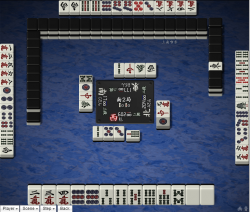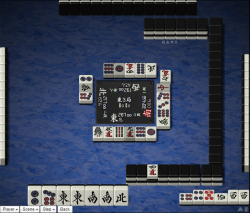Riichi strategy

Strategy surrounding the call for riichi entails various considerations. Players may very well blindly call riichi without any thought. Sometimes, this move pays off; and the player is rewarded. Then on the other hand, players are punished. Even worse, they are dubiously punished. While riichi hands gives players the chance for higher scoring hands, players must not be blinded by the opportunity without considering the risks. Sometimes, that riichi call may not be necessary anyways. Regardless, players win or lose on the risk-reward nature of the riichi declaration.
Advantages

- Any closed hand becomes eligible for winning by ron.
- Riichi is an automatic yaku and is eligible to count for 1 additional han (after a win).
- A win via tsumo is guaranteed an extra han from mentsumo.
- A possible 3-han riichi combination of: riichi, ippatsu, and mentsumo.
- Access to the uradora (after a win).
- Kans formed by any player provide two extra dora indicators (per kan declaration) for the riichi declarer instead of just one.
- Other players are recommended to defend against riichi calls, if possible or needed. Otherwise, players run the risk of falling to that hand.
Disadvantages
- By rule, the hand is locked. Therefore, it is impossible to change the composition of the hand in order to get a better wait or an improved score.
- Changing a hand while in riichi breaks this rule and imposes chombo.
- Likewise, a player can no longer defend and must wait for a winning tile.
- Other players retain the ability to develop their hands, if they choose not to defend against the riichi.
- Defending players are less likely to deal in.
- It is highly recommended to declare the win on the first instance of a winning tile, even if the tile is a yasume or a lower scoring tile (based on yaku). Otherwise, the hand is subject to furiten. Of course, this decision rests on the current scores.
- A riichi call disables a person's ability to be selective of points from particular players (if need be).
- A "riichi stick" of 1,000 points is temporarily spent to call the riichi, with the hopes of winning it back. However, other players may win the hand and capture those 1,000 points instead.
Considerations for riichi
Once again, riichi is a discretionary play. In fact, in all instances of considering and calling riichi, risk is involved. Therefore, various factors must be considered before employing using riichi. At the same time, many plays involving riichi are highly recommended. Employing riichi is a matter of the current game state.
Damaten
The alternative to declaring riichi is damaten. This move involves retaining the closed hand in tenpai, without making a declaration.
Defense
A riichi call does prompt other players to play even more defensively. At the same time, a player cannot defend after calling a riichi. Yet, one seemingly obvious fact can easily be ignored: the last chance a riichi caller can defend may be at the riichi call itself. Plenty of times, tenpai is attained just before, that riichi declaration is considered and made. Often, a player must discard one particular tile in order to attain tenpai; this is the "leaked tile". At this point, defensive considerations on that leaked tile may be overlooked, because of the riichi opportunity. If it happened to be a dangerous tile, then that riichi opportunity suddenly becomes a point gain for another player. In a sense, one must "look before leaping".
Furiten
At times, a player may not be able to avoid furiten, especially when tenpai. Then the chance to call riichi comes. Being in furiten, the riichi becomes solely dependent on tsumo. One riichi is called, then this situation becomes a furiten riichi 「振聴立直」. At times, a hand in riichi depends on tsumo anyways regardless of furiten status, when the other players defend against it.
Game round
Early riichi have the advantage of applying early pressure on opponents, by looking to develop some kind of early lead. It is an opportune time, because the other players seek to posses such an advantageous position. Like always, an early riichi may also be susceptible to later pitfalls, when the hand development of other players actually catches up to the early riichi and pose their own threats as well. Suddenly, the advantage of the early riichi becomes its own pitfall. Even so, players who fall behind early have a chance come back into the game, when falling early rather than later.
As for later rounds, players may not seek to use riichi or apply a limited use. The chance to make up significant point losses is naturally decreased in the later rounds. Thus, it becomes ever more difficult to make up lost ground later in the game.
Hand shape and waits
After a riichi call, the likelihood of the hand winning places itself on its hand shape and tile waits. Hands with waits of three tiles or greater, such as ryanmenten or sanmentan, have a favorable chance of winning. One tile waits, such as kanchan or even tanki, can sneak its way to a winning hand, before the "favorable" hand does. So, quantity does not necessarily imply a guarantee; yet it certainly does factor towards the riichi call. Often, the liklihood of winning encourages players to making that riichi call.
Luck
Point standing
During the course of the game, it is important to be aware of the current point standings. This places multiple considerations during the game, particularly regarding riichi. Players with significant point deficits may not have much of a choice with riichi and desperately needs the benefits, regardless of the risk. On the other hand, players with a considerable lead does not need riichi. The indefensible position of riichi is certainly unnecessary, when in possession of a large lead.
Games with a tighter point distribution requires greater discretion. Sometimes, the 1,000 points spent on riichi (without winning it back) is enough to determine overall placement.
Oikake riichi
Oikake riichi 「追いかけリーチ」 is a declared riichi, after another player had already declared riichi. In this state, two or even three players have simultaneously declared riichi; and thus, the game becomes a contest between two or three tenpai hands. In this state, any riichi declarer is liable of playing into another's riichi call. At the time same, this type of riichi is often utilized because at least one player is not able to defend. With multiple riichis occurring simultaneously, the players end up in a "riichi duel".
The process of four active riichi hands is not possible due to suucha riichi, or four called riichi. In this case, the hand ends if the fourth riichi discard is not a winning tile for any of the previous three.
External links
| |||||||||||